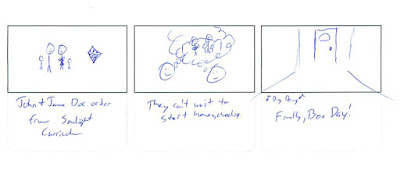It all starts with story. And while writing out a story in script format can be helpful, sometimes it's just too much of a hassle to try to translate it into words and scenes and such.
That's why when I'm about to produce a short, I often print off a couple pages of my handy blank storyboards and start sketching. It's often much easier to convey the gist of my story with pictures. This also helps me think through how the visuals and voice over will interact. I can demonstrate sound effects, camera motion, even expressions faster and easier in this format than in a script.
And here's the beautiful thing: You don't have to be an artist. I'm a stick-figure-drawer kind of guy, and my storyboards totally work:

Frames from My Most Recent Storyboard
All it has to do is communicate. It'd be nice to be Rembrandt if you were trying to create static art. But you're not. You're trying to make a short and the faster you can toss together your pieces the better.
So, get to it!
~Luke Holzmann
Your Media Production Mentor







